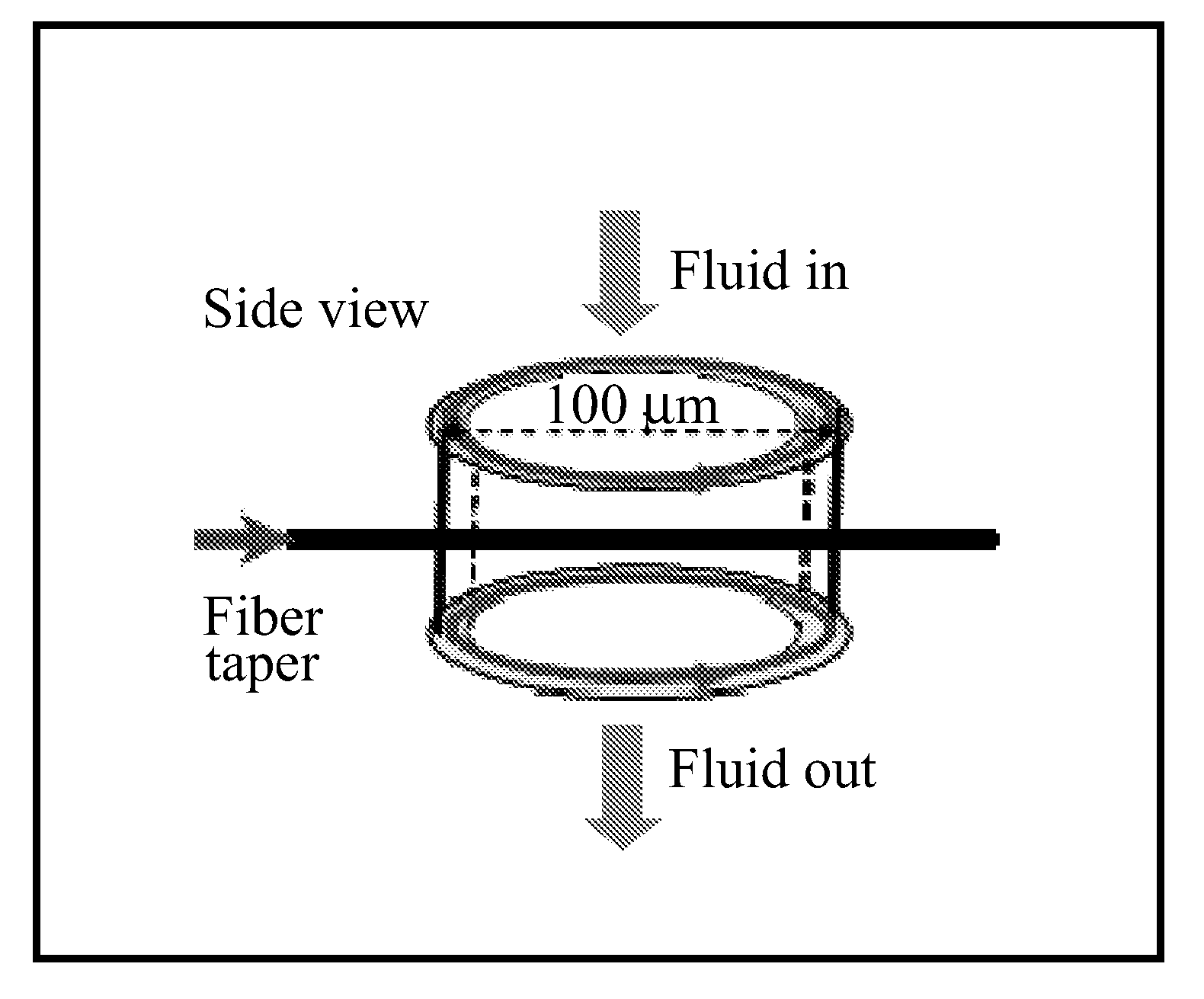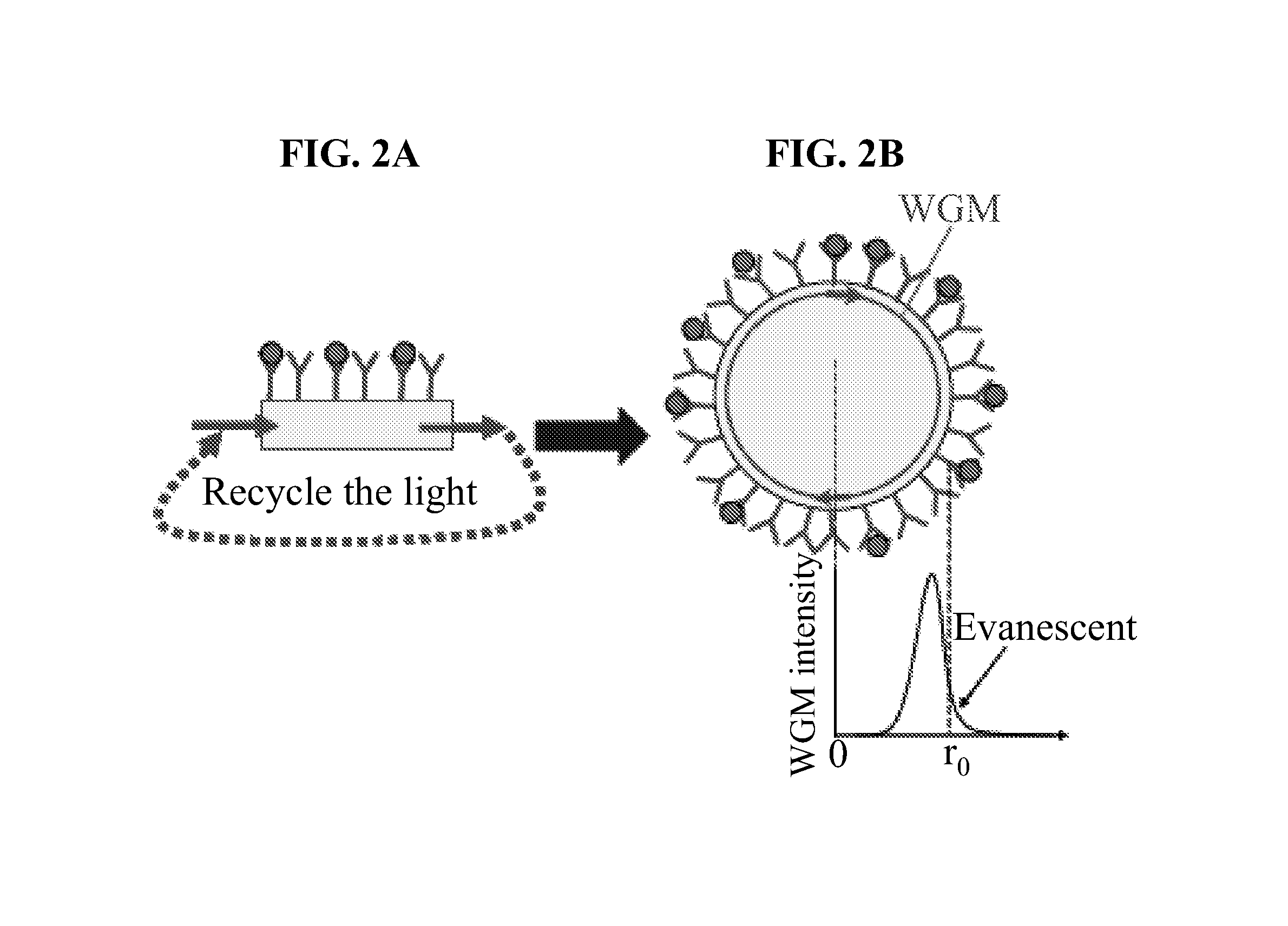Hollow Core Optical Ring Resonator Sensor, Sensing Methods, and Methods of Fabrication
a ring resonator and optical core technology, applied in the field of hollow core optical ring resonators, can solve the problems of degrading q-factors of micro-disks (or micro-rings), difficult mass production of microspheres, and limited use of evanescent wave sensors, etc., to achieve low sample consumption of ring resonators, high sensitivity, and high compatibility
- Summary
- Abstract
- Description
- Claims
- Application Information
AI Technical Summary
Benefits of technology
Problems solved by technology
Method used
Image
Examples
example 1
[0091]The following example relates to a method of fabricating a HCORR. Specifically, an HCORR was formed by etching and pulling the center section of a fused silica capillary (r1˜0.45 mm, r2˜0.6 mm). The capillary was first pulled under an H2O flame (using the mechanical pulling set-up illustrated in FIG. 13) until the outer radius reaches about 35-50 μm. To achieve the desired wall thickness, the elongated capillary was etched by pumping low concentrations of HF (<10%), preferably about 5% HF, through the hollow care of the capillary for a period of 30 minutes to 2 hours. After final-etching, the resulting capillary was rinsed by pumping water through its hollow core, which yielded the desired HCORR with a wall thickness of about 2 to 4 μm. FIG. 17 shows an SEM image of about one quarter of the cross section of an HCORR.
example 2
[0092]The HCORR device described in Example 1 was tested. During the sensing application, the HCORR was positioned in contact with a fiber taper of approximately 3-4 μm in diameter to obtain a WGM spectrum. Light from a tunable laser diode (980 nm) was coupled into the WGM through the evanescent coupling at the HCORR exterior surface. The tunable laser was repeatedly scanned across a wavelength range of about 100 μm. The WGM spectral positions were recorded at the output end of the taper.
[0093]The sensing capability of a HCORR sensor has been assessed by detecting changes in refractive index when a solution of ethanol and water was delivered through the sensor's hollow core. Incremental concentrations of 10%, 20%, 30%, 40%, 50%, and 60% were pumped through the HCORR with a rinsing step between each increment to ensure that the HCORR was free of residual ethanol from the prior increment. Two exemplary HCORRs were used with wall thickness of about 3.6 μm (▴ in FIG. 18) and 3.0 μm (▪ i...
example 3
[0096]In addition to the tests described above (ethanol and water), the HCORR device described in Example 1 was also tested on additional target analytes including methanol. In particular, the HCORR sensor has also been employed to detect changes in methanol concentration based on the changes in refractive index when a solution of methanol and water was delivered through the sensor's hollow core. Incremental concentrations of methanol (1%, 2%, 3%, 4%, 5%, 6%, 7%, 10%, 20% v / v in water) were pumped through the HCORR with an outer diameter of about 80 μm and a wall thickness of approximately 2 μm. A rinsing step between each increment was conducted to ensure that the HCORR was free of residual methanol from the prior increment. The result is shown in FIG. 19.
[0097]While the invention has been described in connection with specific embodiments thereof, it will be understood that the inventive method is capable of further modifications. This patent application is intended to cover any va...
PUM
 Login to View More
Login to View More Abstract
Description
Claims
Application Information
 Login to View More
Login to View More - R&D
- Intellectual Property
- Life Sciences
- Materials
- Tech Scout
- Unparalleled Data Quality
- Higher Quality Content
- 60% Fewer Hallucinations
Browse by: Latest US Patents, China's latest patents, Technical Efficacy Thesaurus, Application Domain, Technology Topic, Popular Technical Reports.
© 2025 PatSnap. All rights reserved.Legal|Privacy policy|Modern Slavery Act Transparency Statement|Sitemap|About US| Contact US: help@patsnap.com



